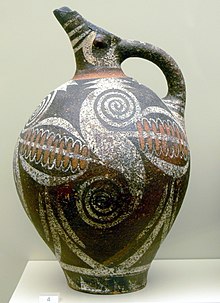
Kamares ware is a distinctive style of Minoan pottery produced by the Minoans in Crete. It is recognizable by its light-on-dark decoration, with white, red, and orange abstract motifs painted over a black background. A prestige style that required high level craftsmanship, it is suspected to have been used as elite tableware. The finest pieces are so thin they are known as "eggshell ware".
Contents
- Description
- Historical development
- Middle Minoan IA
- Middle Minoan IB
- Middle Minoan II
- Middle Minoan III
- Gallery
- See also
- References
- Further reading
- External links
The style first appeared during the Middle Minoan IA period (c. 2100 BCE) and remained an active part of Minoan culture until the Late Minoan IA period (c. 1450 BCE). Though manufactured in Crete, Kamares pottery was traded across the Aegean and eastern Mediterranean, and has been found as far away as the Levant and Egypt.









